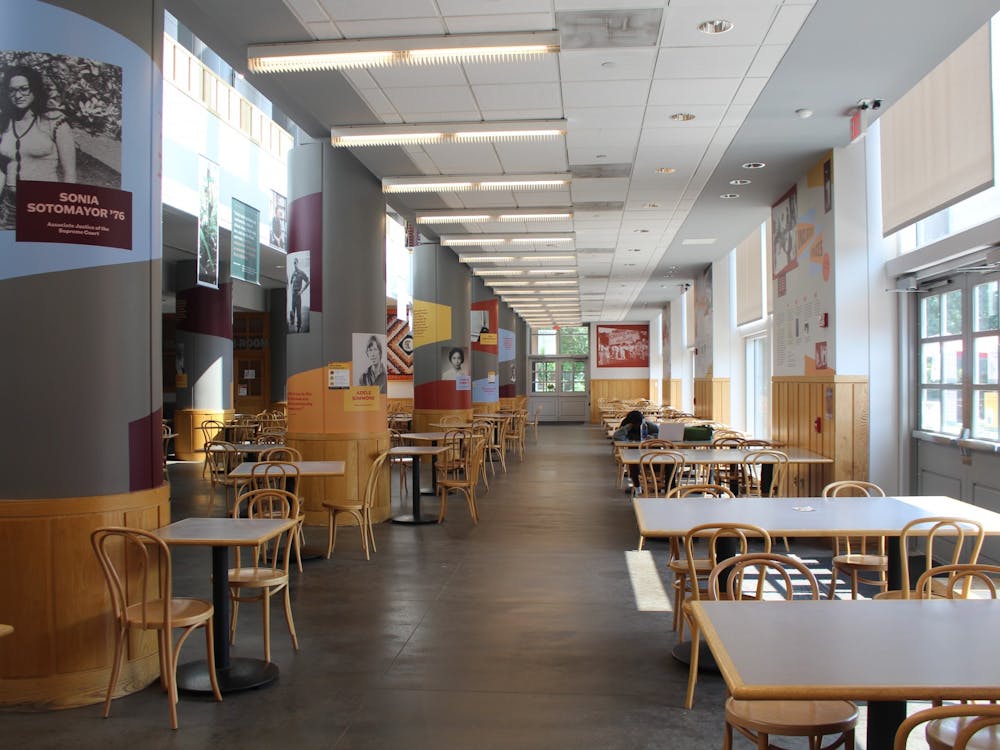Imagine Princeton without Bicker.
Leaving aside for a moment the questions of where students would eat and how club membership would be decided, try to imagine the University without one of its most controversial and distinctive institutions — one that has endured for more than a century, even in the face of sharp criticism for its divisiveness and exclusivity.
Every spring, hundreds of sophomores vie for a spot in one of Prospect Avenue’s five bicker clubs: Cap & Gown Club, Cottage Club, Ivy Club, Tiger Inn and Tower Club. The bickerees take turns participating in activities like swallowing live goldfish and faking orgasms, trying to impress club members who will later discuss and vote on whom to accept. Last spring, however, only 61 percent of those bickerees were admitted to the club of their choice.
Often criticized as a hurtful process that perpetuates racial and socioeconomic disparities in the eating clubs, Bicker is unlikely to be abolished anytime soon, several students and administrators said. Many of them added, though, that they thought the system could be improved to be less devastating for hosed bickerees and allow students more flexibility.
“I think that some form of Bicker will always exist,” USG president Connor Diemand-Yauman ’10 said in an e-mail. “That is why I think the system should be continually re-evaluated and improved.”
The Bicker process favors certain demographic groups over others, according to an October 2009 evaluation of the Committee on Background and Opportunity (COMBO) survey results by the USG’s Analysis of Princetonian Attitudes Committee (APAC). Students who are white and are from high-income backgrounds are more likely to bicker successfully, as are members of Greek organizations and athletic teams, according to the COMBO data. In 2007, more than half of all black students at Princeton were not members of eating clubs, and more than half of all Asian students were members of sign-in clubs. Almost no non-white students who reported family incomes less than $150,000 per year also reported that they were members of Ivy, Cottage or TI.
Fifty-nine percent of respondents to the COMBO II survey did not bicker, and 41 percent did. Of those who bickered, 44 percent bickered Tower, 23 percent Cap, 17 percent Ivy, and 8 percent each Cottage and TI.
Vice President for Campus Life Janet Dickerson explained that, for her, the main problem presented by Bicker is the effect it has on students who are not admitted. For these students, she said, rejection is “a really disappointing experience, life-changing in ways that they hadn’t really expected.”

Interclub Council adviser Tim Prugar ’06 said that such consequences have been a “discussion as long as Bicker has existed” and are “certainly a negative aspect of the process.”
He noted, however, that the Street provides other options for students who want to take part in the eating club experience. “If the student finds the process particularly uninviting, they are more than welcome to sign into sign-in clubs,” he explained.
“I don’t think that Bicker defines the eating club system, nor that [it’s] the single most prominent aspect of it,” he added. “It’s one of two options that exist on Prospect Avenue.”
Dickerson acknowledged that each club “has a right to have its own procedures for inducting its members.”

“I don’t feel as if it’s my right to tell clubs what to do, and I don’t feel any responsibility to do so,” she added, though she expressed concern over the emotional toll the Bicker process takes on students. “I guess I just wish that no student would have to go through an experience where they were so rejected for what I think of as relatively inconsequential reasons — because there wasn’t enough space in the club, or because someone blackballed them and didn’t like them, or because they weren’t social enough or were too social,” she said.
Jordan Bubin ’09, a former Tower member, said that the clubs will likely remain for some time because they were founded and continue to be funded by “students who had enough cash to build their own alternatives for dining halls.”
“Princeton will always have some subset of kids who have that sort of disposable cash … I think that they will exist for some time in some way or another,” he noted.
Though all of the eating clubs were all bicker clubs initially, some have switched to a sign-in system for member selection, beginning with Colonial and Terrace in the 1960s. The five current bicker clubs have been the Street’s only bicker clubs since the 1970s, but some have questioned whether the process could be eliminated entirely and, if so, how this would affect the Street.
University Vice President and Secretary Bob Durkee ’69 said that, during his undergraduate years, when all of the clubs held Bicker, it was a very different process.
“As a sophomore, you didn’t declare which club you were interested in. You sat in your room for three or four days as delegations from any of the 15 clubs that were interested came and talked with you,” Durkee explained. “Each of the 15 clubs made decisions about which sophomores they were going to invite to join. You might get one or two bids, you might get six or seven bids, you might get 15 bids.”
Durkee added that, back in the ’50s, by policy, and the ’60s, by practice, every student who bickered received at least one bid — and often more than one — from a club.
“If you didn’t end up in the club you had your heart set on, I don’t think it felt as devastating as it may now,” he said.
The Bicker process and the eating club system have departed from this concept of “100 percent Bicker” practiced in the past, and Durkee noted that one advantage of the older model of Bicker was that it was less likely to separate students from their friends. A student could enter Bicker with a group of friends, he recalled, and “for the most part, clubs would honor that.” The current model, he noted, is not as conducive to that possibility.
Dickerson said she hoped the Bicker system might one day include a “multiple Bicker process.” In such a system, she explained, if a student was rejected from one bicker club, he or she might be able to bicker another. “The way it’s set up now, your options are really, really limited,” she said. “You put your hat in one circle, and you hope that they will choose you, and if they don’t, you don’t have a backup plan.”
Historically, Bicker is the element of club life that the University administration has been the most critical of. Several past University presidents — including Woodrow Wilson, Class of 1879, and Robert Goheen ’40 — have denounced the process. For her part, President Tilghman expressed concerns about it during an interview with The Daily Princetonian this past summer.
“I think the Bicker process is one that divides the student body, that it causes a lot of pain for students who are unsuccessful,” Tilghman said. “If we could evolve into a system where there is a less divisive way for students to become members of eating clubs, that’s what I would like to see … It’s going to be slow, and it’ll involve primarily student leadership.”
Many of those interviewed noted that they believe the current relationship between the clubs and the administration is a marked improvement over the past.
“I think that behind the scenes, the relationship between the eating clubs and the University is fairly strong and continuing to improve,” Diemand-Yauman said.
Prugar echoed Diemand-Yauman’s statement. “There is a strong relationship between the ICC and the University, and one that I’d like to see continue because it’s positive,” Prugar said.
In September, Tilghman formed a task force, chaired by Durkee, to examine the relationship between the University and the eating clubs and look at the selection process for students hoping to become members.
Genevieve Ryan ’11, a Cottage member who sits on the task force, said she thought the eating club system was a “very unique and special tradition.”
“Capacity-wise, I don’t think it’s possible to end Bicker,” she explained.
Cap member Bianca Williams ’11 expressed a similar sentiment. “The Bicker process definitely gets a bad rep,” she said. “A lot of people do Bicker, and we don’t have enough space for all of those people, and as long as it’s not so much hazing and more so concentrated to getting to know people, it’s a good thing.”
Ted Price ’10, who successfully bickered Ivy in his sophomore year, said his Bicker experience was generally positive.
“The actual process of Bicker is fun, but what it means isn’t that great because of the exclusivity that it breeds,” Price said. “In some respects, it is kind of what it’s like in the real world. That kind of stuff happens, and that’s kind of the way it is.”
“I don’t know if that’s what it should be like in college,” he added. “I don’t know.”
Colonial president Alex Man ’10 explained that sign-in clubs like his operate on a completely different philosophy. “We don’t pick our members; our members pick us,” he explained. “It’s a different idea because a bicker club can actually enforce limitations on who gets in and who doesn’t. That’s the whole point of Bicker: Some people get in, and some don’t.”
Club officers emphasized the amicable relationship among the ten institutions, despite the fundamental difference that exists between the bicker and sign-in clubs based on their membership selection process.
“I don’t think it’s necessarily a bicker/sign-in divide as much as it’s 10 different clubs, 10 different memberships, 10 different club cultures,” Prugar said. “They all cater to different people.”
Man echoed Prugar’s sentiment, noting that the eating clubs “complement” one another.
Prugar added that the ICC meetings each Monday present a more unified side of the Street. “It’s jovial. It’s friendly. It’s 10 Princeton students. So I don’t think the division [between the clubs] is as existent as most people think it is,” he explained.
So can students imagine a Princeton without Bicker? The overwhelming majority of undergraduates interviewed for this article seemed to think they couldn’t. And many of them said they thought that was for the best.
“I think the main thing is trying to get away from the idea that it is super-exclusive and that you’re hazing people who are trying to get into your club,” Williams said. “That’s not the point. The point is to get to know them and see if they’d be a good fit, see if you’d like to have a meal with them.”
Still, not all students said they thought Bicker was an indispensable Princeton tradition.
“I don’t think [Bicker is] essential to the eating club system,” Price said. “I think it’s essential to the exclusivity of the eating club system.”
This is the last article in a five-part series on the eating clubs and the COMBO data.







